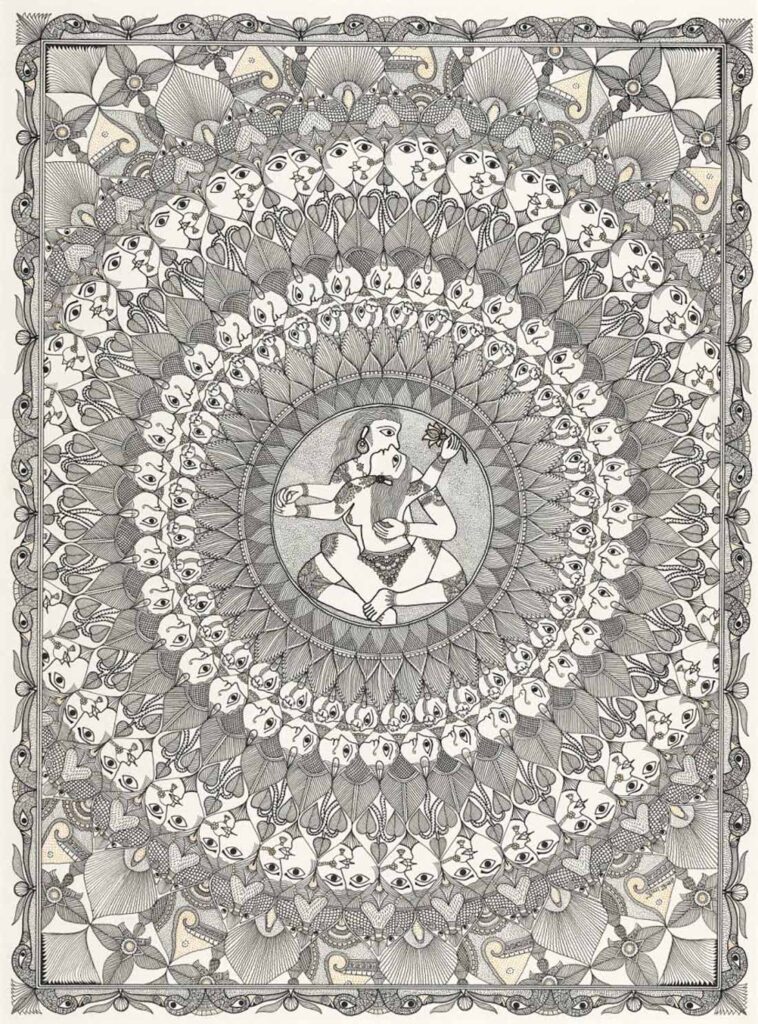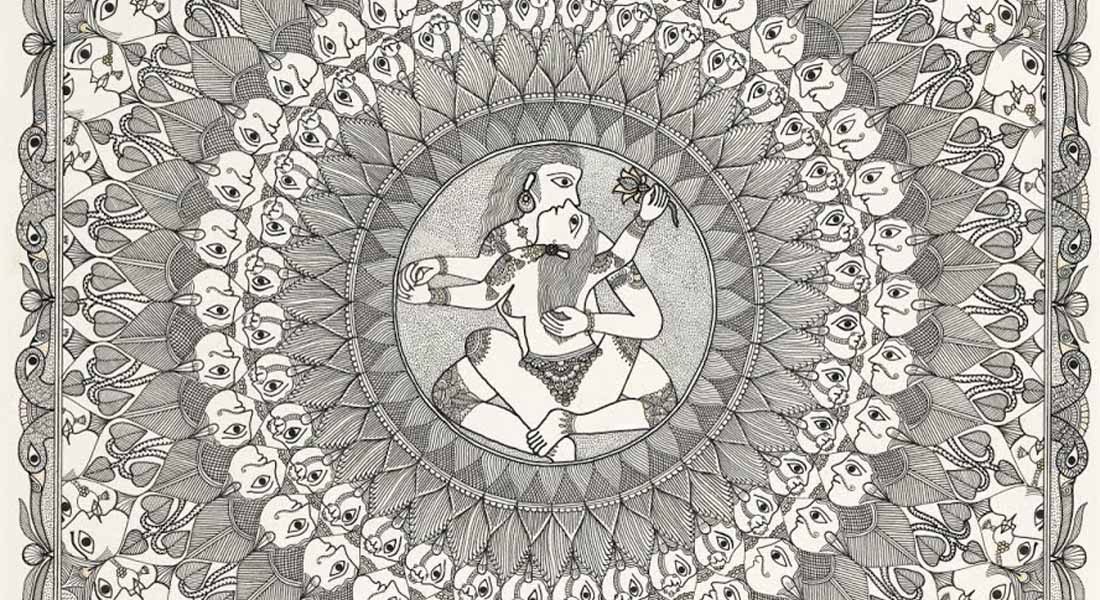Minhazz Majumdar
Eminent writer
–
Intense and quiet, Pushpa Kumari grew up in her maternal grandparent’s home, surrounded by beautiful Madhubani paintings made by her grandmother, Maha Sundari Devi, one of the foremost Madhubani painters of India. Traditionally, for centuries, the women of Madhubani, Mithila district had done beautiful colorful drawings on the floors and walls of their homes, depicting religious and social themes. These paintings were means of visual education, a way of passing down stories, myths, and social values from one generation to another. The marriage chamber or kobhar ghar has elaborate paintings on the walls, filled with fertility symbols and seamlessly combining the spiritual with the sexual. A severe drought in Mithila in 1966-67 heralded the transformation of this art – the government in an attempt to generate employment and income, started encouraging the women to paint on paper. Along with other notable artists such as Ganga Devi, Jamuna Devi and Sita Devi, Maha Sundari Devi contributed tremendously to popularising this style of painting by being one of the pioneers to transfer onto paper the traditional wall and floor art of Mithila.
The eldest of four sisters, Pushpa was sent to her grandmother’s house at a young age to provide companionship, and bring laughter and light into a home where all the children had grown up. Her mother and siblings lived close by in her father’s ancestral village and they met often. Her father’s abrupt disappearance when he left home never to return one day, was a turning point in Pushpa’s life. Though still a child, as the eldest, she felt responsible for bringing her sisters up, a task she has shouldered willingly, without rancor, not as she says because anyone asked her to but simply because it felt right. She took to painting very early, and with such felicity that before long, she was selling her works of art. She imbibed her first lessons in painting unconsciously as a child, watching her grandmother and other relatives work their magic with paint on paper. Growing up in this artistic ambiance, it was but natural that Pushpa would take to wielding the brush, and learn well the nuances of Madhubani art.
However, to call Pushpa just a Madhubani artist would be a fallacy for she is all that and much more. What makes Pushpa special is that though she is rooted in her centuries-old tradition, she has incorporated not only contemporary ideas and treatment, but also, an artistic intensity, an aesthetic ideal that is truly her own. Not content with painting the same stereotypical pictures of gods and goddesses or placid pastoral village scenes, Pushpa is constantly seeking new subjects, experimenting with new ways to stretch the boundaries of Madhubani art. Not for her the confining yoke of custom – rather in a chameleon-like move, she shakes off one skin for another, bringing a new perspective into an established art form. What sets her apart is that she uses her works and the stylistic devices of Madhubani paintings to sharply focus and at times, even subtly challenge the subject she has chosen to depict.

The search for appropriate subjects is relentless and all-consuming. The themes for her drawings are garnered from deep within the Hindu epics and holy scriptures, from folk stories, heard half-asleep in her grandmother’s lap, from topical discussions swirling around her, fragments of conversations remembered some later date, stories of obscure heroes and heroines, long forgotten gods and goddesses. And so you have in her pictures, a wide range of subjects and events – episodes from ancient history depicting brave warriors, or universal primordial concerns such as birth and death or contemporary issues such as the rampant female foeticide prevalent in India.
The powerful drawing “The Horse Latitude” is an apt example to illustrate her penchant for working on subjects that are unusual and yet resonate with deep philosophical and spiritual beliefs. This poignant drawing of an upturned horse beneath a large boat is mystifying at first glance as nothing seems to make sense. Delving deep into her remembrance of stories heard as a child, she recalled a story that at the Equator, the gravitational forces are so strong, exerted from all four directions that nothing can move in any direction. Therefore, when a ship reached the Equator, it would stop moving, unable to counter the strong pull from every side. Ships usually carried horses in their holds and once they reached the Equator, they would throw the horse overboard. The waters agitated by the movement of the horse as it struggled to stay afloat, would then push the ship over the Equator, freeing it from the stranglehold of gravity. For this reason, the Equator was called the Horse Latitude. The theme though unusual is made even more remarkable by its symbolic significance – for in Pushpa’s words, to move forward, one has to often sacrifice something precious, and one form of Shakti (energy) has to be played out to be replaced by another. The hapless horse stands for all that we sometimes have to give up to keep going on in the journey that is life, and the fragile umbrella stands for a protecting force.
For Pushpa, her drawings represent her retreat, a silent sacred space where she can be as she chooses to be. She can be as compulsive, obsessive, quiet, spiritual, angst-ridden, and comical as she wants, removed from the cares and stresses of daily existence. She can go on journeys of discovery, flights of fantasy and discover all that is good or bad, sad or happy about life and the living, the gods and goddesses revered so greatly. When she spends hours together filling a blank sheet with a fine filigree of lines, it is a form of meditation for her, so deep is her concentration on the task at hand. Only madness or genius can achieve such amazing intensity and Pushpa definitely scores as the latter. She is an artist breaking free, ushering in a fresh perspective into a centuries-old tradition and taking it forward to new aesthetic brilliance. She is a woman of uncommon vision, with a unique gift of telling tales through her art, which, regardless of geographic or cultural barriers, touches every heart.
–
Courtesy: https://artfoundout.blogspot.com/
Title: Pushpa Kumari by Minhazz Majumdar
Tags: Contemporary Mithila artists, Contemporary Mithila painting, Mithila painting, Pushpa Kumari

